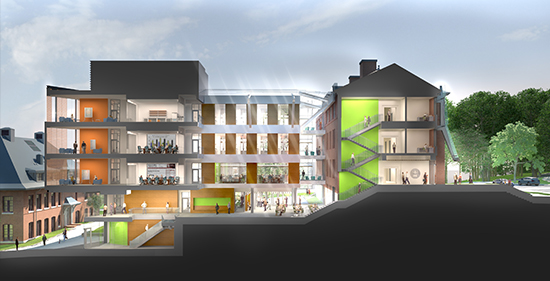
We’re excited to share a bit about our transformative project for Tufts University, as enabling work is now underway to prepare the site for eventual construction. The primary mission of the Science and Engineering Complex is to reinforce a particular Tufts pedagogy: the integration of undergraduate and graduate teaching and research across many scientific disciplines. To achieve this goal, the project is located on a triangular site in the heart of campus, which is a key crossroads of existing science and engineering facilities, new facilities and major pedestrian routes through campus. The new building will be integrated with two existing buildings, Anderson and Robinson Hall, establishing an optimal central location for the University’s core science and engineering programs.
The integrated complex will create a critical mass of research and teaching to support cross-departmental collaborations, such as Environmental Sciences for Global Change and Neurosciences. The new building will be comprised of two research lab wings that contain flexible lab suites on each floor in order to accommodate a wide array of research and specialized scientific core facilities. The two lab wings, in concert with the adjacent, existing buildings, come together to form an L-shaped atrium that will be the social heart of the complex. The activity created at this intersection mirrors the integration of undergraduate and graduate teaching and research housed within the new complex.
The Science and Engineering Complex will be one of the most energy-efficient buildings of its kind in the United States. The facility is designed to be a model for sustainability standards and building performance; the goal for the project is LEED Platinum certification from the U.S. Green Building Council.
To learn more about the Science and Engineering Complex, and to keep updated on construction, please visit the University’s new project page.



